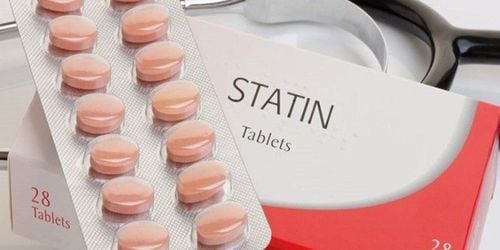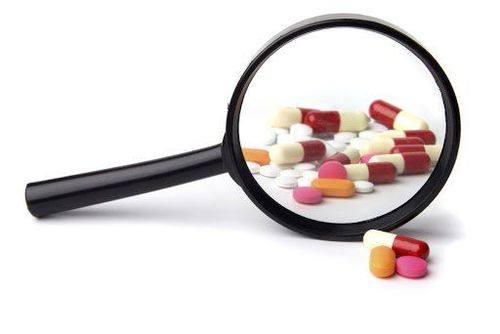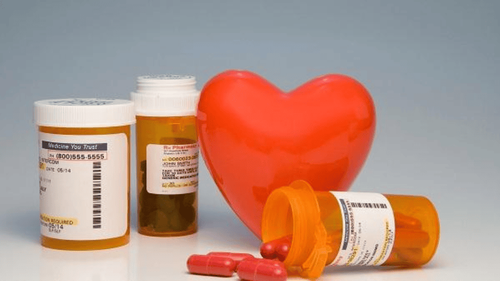This is an automatically translated article.
The article was professionally consulted with Senior Doctor, Specialist II Doan Du Dat - General Internal Medicine - Department of Medical Examination & Internal Medicine - Vinmec Ha Long International Hospital.Hypertension has two forms:
Primary hypertension, accounting for 90-95% Secondary hypertension (High blood pressure is just a symptom of other diseases such as coarctation of the aorta, severe regurgitation of the aortic valve, Adrenal tumors...) account for 5-10% Primary hypertension is a common disease today. The disease was defined as systolic blood pressure ≥ 140 mmHg and/or diastolic blood pressure ≥ 90 mmHg. Patients with hypertension must take medication to control blood pressure within the allowable range, avoiding possible dangerous complications.
Primary hypertension, accounting for 90-95% Secondary hypertension (High blood pressure is just a symptom of other diseases such as coarctation of the aorta, severe regurgitation of the aortic valve, Adrenal tumors...) account for 5-10% Primary hypertension is a common disease today. The disease was defined as systolic blood pressure ≥ 140 mmHg and/or diastolic blood pressure ≥ 90 mmHg. Patients with hypertension must take medication to control blood pressure within the allowable range, avoiding possible dangerous complications.
1. Antihypertensive drugs (Commonly applied in the treatment of primary hypertension)
The majority of hypertension is unexplained (primary elevation), with only 10% of cases having an obvious cause (secondary elevation). Hypertension is a chronic disease that requires lifelong monitoring, correct and adequate treatment every day, long-term with antihypertensive drugs to achieve the goal of < 140/90 mmHg or even lower if the person disease is still tolerable.Patients can use antihypertensive drugs in 2 levels:
Antihypertensive drugs for grade 1 (only 1 drug in groups): low-dose thiazide diuretics, ACE inhibitors, long-acting calcium channel blockers, beta-blockers (if no contraindications). Medications to treat hypertension grade 2 or higher: The doctor will combine 2 types of antihypertensive drugs (diuretics, calcium channel blockers, ACE inhibitors, angiotensin II AT1 receptor blockers). or beta-blockers) to treat the patient. Accordingly, the classes of antihypertensive drugs are classified as follows:
1.1. Diuretics to treat high blood pressure
Diuretics to treat hypertension, which work by reducing plasma volume, reducing vascular resistance through the movement of sodium ions from the inside out of the cells, include:Thiazide diuretics (hydrochlorothiazide, Indapamide, Methyclothiazide or Chlorothiazide...); Loop diuretics (furosemide, Torsemide, Ethacrynic Acid, Bumetanide...); Potassium-sparing diuretics (amiloride, Eplerenone, Spironolactone, Triamterene...). In addition to acting as an antihypertensive drug, diuretics also have a mild vasodilating effect. Thiazide diuretics are the most commonly used diuretics in the treatment of hypertension. Loop diuretics are usually used only for the treatment of hypertension in patients who have lost >50% of renal function in divided doses twice daily.
For potassium-sparing diuretics, although they do not cause hypokalemia, they are not as effective as thiazide diuretics in controlling blood pressure for patients. Therefore, in hypertensive patients, potassium-sparing diuretics should not be used for initial therapy.
1.2. Beta blockers for high blood pressure
Antihypertensive drugs of beta-blocker group (Bisoprolol, Metoprolol, Labetalol, Nebivolol, Propranolol, Timolol, Carvedilol, Atenolol...) act by slowing heart rate, reducing myocardial contractility, thereby for lowering blood pressure in patients. All beta-blockers have similar antihypertensive effects.In particular, beta-blockers are useful in patients with angina, myocardial infarction, or heart failure (although atenolol may worsen the prognosis of coronary artery disease). Beta-blockers are contraindicated in patients with second- and third-degree AV block, bronchial asthma, or sinus node insufficiency syndrome.
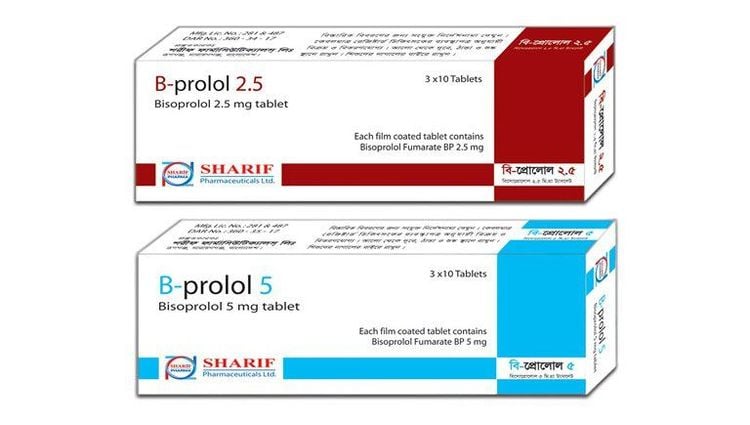
Thuốc điều trị tăng huyết áp nhóm chẹn beta giao cảm Bisoprolol
1.3. Calcium channel blockers for high blood pressure
Calcium channel blockers are divided into 2 subgroups: Dihydropyridine calcium channel blockers (amlodipine, felodipine, nifedipine, nisoldipine, isradipine...) act by a strong peripheral vasodilator mechanism. , which lowers blood pressure by reducing peripheral vascular resistance. Dihydropyridines sometimes also cause a reactive tachycardia. Nondihydropyridine calcium channel blockers (verapamil, diltiazem) act by slowing the heart rate, reducing atrioventricular conduction, reducing myocardial contractility, thereby leading to a hypotensive effect. This class of drugs should not be used in patients with 2nd or 3rd degree AV block or in patients with left ventricular failure. Calcium channel blockers are preferred over beta blockers in patients with stable angina accompanied by bronchospasm, coronary spasm, or Raynaud's syndrome.1.4. ACE inhibitors (ACE inhibitors)
ACE inhibitors (benazepril, captopril, enalapril, fosinopril, lisinopril, perindopril, quinepril, ramipril, trandolapril...) reduce blood pressure by inhibiting the conversion of angiotensin I to angiotensin II, thereby reducing resistance Peripheral. In particular, this group of drugs does not cause reflex tachycardia (different from the calcium channel blocker Dihydropyridine which causes reflex tachycardia).ACE inhibitors are preferred for treatment in the group of hypertensive patients with diabetes because of their renal protective effect. However, the drug has side effects of dry cough, angioedema. Therefore, if the patient has laryngeal edema (most common in blacks and smokers), it should be used with caution.
1.5. Angiotensin II receptor blockers for high blood pressure
Angiotensin II receptor blockers (azilsartan, candesartan, eprosartan, irbesartan, losartan, olmesartan, telmisartan, valsartan...) act by binding to angiotensin II receptors and inactivating them, thereby inhibiting the renin system - angiotensin. Antihypertensive drugs of angiotensin II receptor blocker and ACE inhibitor valsartan will have similar antihypertensive effect because they act on the same renin - angiotensin system. Therefore, angiotensin II receptor blockers should not be used concurrently with antihypertensive agents of the ACE inhibitor class.1.6. Some other antihypertensive drugs
Direct renin inhibitors (Aliskiren): Drugs that will directly block renin to help treat high blood pressure. Therefore, Aliskiren should not be combined with ACE inhibitors or antihypertensives of the angiotensin II receptor blocker class. Adrenergic agonists (alpha-2 agonists, postsynaptic alpha-1 receptor blockers...). Alpha-2 agonists (methyldopa, clonidine...) reduce sympathetic nervous activity, lower blood pressure, but have the ability to cause drowsiness, lethargy, depression, so they are less widely used. Postsynaptic alpha-1 blockers (prazosin, terazosin, doxazosin) despite their antihypertensive effects are no longer used as antihypertensive agents because they do not reduce mortality but are used Many patients have benign prostatic hypertrophy. Direct vasodilators (minoxidil and hydralazine) that act directly on the blood vessels should be used for severe, refractory hypertension. Hydralazine can be used by pregnant women.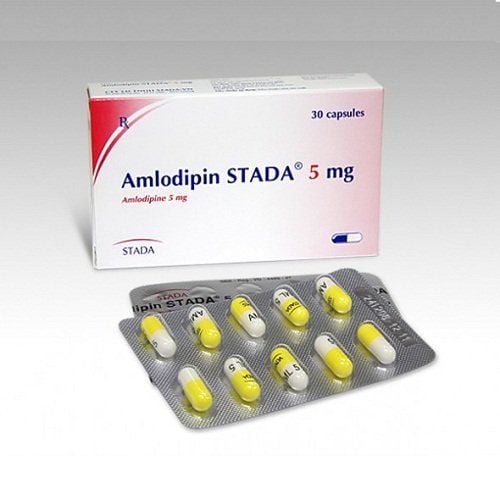
Thuốc điều trị tăng huyết áp Amlodipin
2. Active ingredient for treating hypertension Amlodipine besilat
Amlodipine besilate is an active antihypertensive drug belonging to the group of calcium channel blockers Dihydropyridine. This active ingredient is currently circulating on the market with trade names such as: Amlor, APITIM 5 ... with a content of 5mg. The drug is indicated for use in the treatment of hypertension, chronic stable angina, and vasospastic angina (Prinzmetal's angina).For adult hypertension and angina, the starting dose of Amlodipine is 5 mg once daily, which may be increased to a maximum of 10 mg once daily depending on response. Amlodipine can be used concurrently with thiazide diuretics, alpha-blockers, beta-blockers, ACE inhibitors... In angina, amlodipine can be used as monotherapy or concurrently with anti-inflammatory drugs. other angina in patients resistant to nitrate derivatives and/or beta-blockers. In particular, the tolerability of elderly and young patients is similar when using similar doses of amlodipine.
For children 6 - 17 years of age, the recommended starting dose of Amlodipine besilate is 2.5 mg - once daily. Then, if the desired blood pressure value has not been achieved after 4 weeks of treatment, it can be increased to 5 mg - 1 time / day.
Amlodipine is contraindicated in patients sensitive to dihydropyridine derivatives, severe hypotension, patients in shock (including cardiogenic shock), left ventricular outflow tract obstruction (severe aortic stenosis), hemodynamically unstable heart failure after acute myocardial infarction.
Amlodipine has been shown to be safe in combination with thiazide diuretics, alpha adrenergic blockers, beta adrenergic blockers, ACE inhibitors, long acting nitrate vasodilators, sublingual nitroglycerin, nonsteroidal anti-inflammatory drugs, antibiotics and hypoglycemic agents.
In short, to protect health, people with high blood pressure should go to the hospital to be examined by a specialist and have a suitable and safe treatment regimen. Currently, Vinmec International General Hospital has basic hypertension check-up packages with a team of medical-physicians who are leading experts, highly qualified, dedicated and devoted to the benefit of patients. . Vinmec is confident about its hypertensive screening service because:
With 90% having university degrees, 20% being professors and associate professors, nearly 30% having doctorate degrees, bringing high efficiency in medical examination and treatment. Healing. Comprehensive and professional medical examination, consultation and treatment services. A system of modern equipment, supporting effective diagnosis and treatment. Modern, civilized, luxurious and sterile medical examination and treatment space. Customers who use the Vinmec Hypertension Checkup Package will enjoy benefits such as:
Cardiology Specialist Examination (with appointment)
Perform tests such as:
Peripheral blood cell analysis (by laser counter) Glucose quantification Cholesterol determination Triglyceride quantification HDL-C (High density lipoprotein Cholesterol) determination of LDL - C (Low density lipoprotein Cholesterol) Determination of Creatinine Determination of Urea Measurement of AST Activity (GOT) Measurement of activity ALT level (GPT) Measurement of GGT activity Electrolytes (Na, K, Cl) Quantitative uric acid Quantitative CRP hs (C-Reactive Protein high sesitivity) Quantitative proBNP (NT-proBNP) Total urinalysis (Eq. automatic) Quantification of MAU (Microalbumin Arine) Normal Electrocardiogram Holter Blood pressure Echocardiogram, transthoracic pericardium, Abdominal ultrasound, Cardiopulmonary radiograph.
Please dial HOTLINE for more information or register for an appointment HERE. Download MyVinmec app to make appointments faster and to manage your bookings easily.




